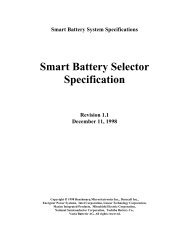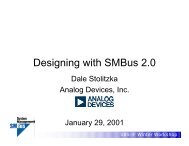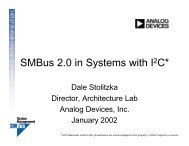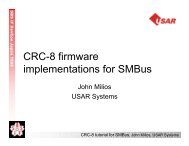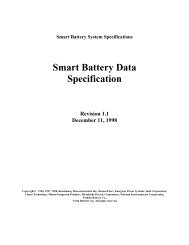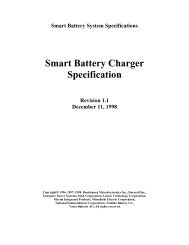Smart Battery System Manager Specification, version 1.0
Smart Battery System Manager Specification, version 1.0
Smart Battery System Manager Specification, version 1.0
You also want an ePaper? Increase the reach of your titles
YUMPU automatically turns print PDFs into web optimized ePapers that Google loves.
<strong>Smart</strong> <strong>Battery</strong> <strong>System</strong> <strong>Manager</strong> <strong>Specification</strong>4.1.3. Implementation GuidelinesTo accomplish these tasks, the SBSM can be implemented in many ways. One very simple system is acollection of five switches that control the SMBus (data), the safety signal, and power:• <strong>Battery</strong> output power• Charger output power• <strong>Battery</strong>-to-charger data• <strong>Battery</strong>-to-charger safety signal• Host-to-battery dataA more complex SBSM could be a combination micro-controller based system that has:• One SMBus port for each <strong>Smart</strong> <strong>Battery</strong>• Emulates the <strong>Smart</strong> <strong>Battery</strong> Charger function• Provides the <strong>Smart</strong> <strong>Battery</strong> <strong>System</strong> <strong>Manager</strong> functionality• Acts as the SMBus host.An SBSM that supports either simultaneous charging and./or discharging have additional capabilities.SBSMs that allow simultaneous discharge must also have the capability to:• Report data from a composite of the batteries supplying power• Report a composite of the alarms from the batteries supplying powerSBSMs that allow simultaneous charge must also have the capability to:• Report a composite of the alarms from the battery(s) being charged power to both the SMBus hostAND the charger(s)• Maintain constant monitoring of the safety signal(s)• Maintain the correct connections between the battery and charger for power, SMBus data and safetysignal.4.2. <strong>Smart</strong> <strong>Battery</strong> <strong>System</strong> <strong>Manager</strong> ModelOne possible, simple <strong>Smart</strong> <strong>Battery</strong> <strong>System</strong> <strong>Manager</strong> model is a system consisting of two <strong>Smart</strong> Batteries, a<strong>Smart</strong> <strong>Battery</strong> Charger and the SBSM in a notebook computer. The diagram below illustrates the typicalpower and data paths when battery A is acting as the primary battery. This diagram shows a <strong>Smart</strong> <strong>Battery</strong><strong>System</strong> <strong>Manager</strong> connecting <strong>Smart</strong> <strong>Battery</strong> A to both the system and the charger. When AC is present, the<strong>Smart</strong> <strong>Battery</strong> can opt to charge itself as required and the system will be powered by the AC source. If ACis not present, the system will be powered by <strong>Smart</strong> <strong>Battery</strong> A.This is exactly the same model used by the <strong>Smart</strong> <strong>Battery</strong> Selector. The differences are in the reportinginterface to the system.SBS Implementers Forum Page 5 Revision <strong>1.0</strong>




